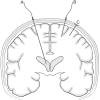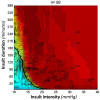Monitoring and Measurement of Intracranial Pressure in Pediatric Head Trauma
- PMID: 32010042
- PMCID: PMC6973131
- DOI: 10.3389/fneur.2019.01376
Monitoring and Measurement of Intracranial Pressure in Pediatric Head Trauma
Abstract
Purpose of Review: Monitoring of intracranial pressure (ICP) is an important and integrated part of the treatment algorithm for children with severe traumatic brain injury (TBI). Guidelines often recommend ICP monitoring with a treatment threshold of 20 mmHg. This focused review discusses; (1) different ICP technologies and how ICP should be monitored in pediatric patients with severe TBI, (2) existing evidence behind guideline recommendations, and (3) how we could move forward to increase knowledge about normal ICP in children to support treatment decisions. Summary: Current reference values for normal ICP in adults lie between 7 and 15 mmHg. Recent studies conducted in "pseudonormal" adults, however, suggest a normal range below this level where ICP is highly dependent on body posture and decreases to negative values in sitting and standing position. Despite obvious physiological differences between children and adults, no age or body size related reference values exist for normal ICP in children. Recent guidelines for treatment of severe TBI in pediatric patients recommend ICP monitoring to guide treatment of intracranial hypertension. Decision on ICP monitoring modalities are based on local standards, the individual case, and the clinician's choice. The recommended treatment threshold is 20 mmHg for a duration of 5 min. Both prospective and retrospective observational studies applying different thresholds and treatment strategies for intracranial hypertension were included to support this recommendation. While some studies suggest improved outcome related to ICP monitoring (lower rate of mortality and severe disability), most studies identify high ICP as a marker of worse outcome. Only one study applied age-differentiated thresholds, but this study did not evaluate the effect of these different thresholds on outcome. The quality of evidence behind ICP monitoring and treatment thresholds in severe pediatric TBI is low and treatment can potentially be improved by knowledge about normal ICP from observational studies in healthy children and cohorts of pediatric "pseudonormal" patients expected to have normal ICP. Acceptable levels of ICP - and thus also treatment thresholds-probably vary with age, disease and whether the patient has intact cerebral autoregulation. Future treatment algorithms should reflect these differences and be more personalized and dynamic.
Keywords: age-dependent; children; guidelines; head trauma; intracranial pressure (ICP); pediatric; reference values; traumatic brain injury (TBI).
Copyright © 2020 Pedersen, Lilja-Cyron, Astrand and Juhler.
Figures



Similar articles
-
Intracranial pressure monitoring among children with severe traumatic brain injury.J Neurosurg Pediatr. 2015 Nov;16(5):523-532. doi: 10.3171/2015.3.PEDS14507. Epub 2015 Aug 14. J Neurosurg Pediatr. 2015. PMID: 26273741
-
Intracranial Pressure Monitoring and Treatment Thresholds in Acute Neural Injury: A Narrative Review of the Historical Achievements, Current State, and Future Perspectives.Neurotrauma Rep. 2023 Aug 7;4(1):478-494. doi: 10.1089/neur.2023.0031. eCollection 2023. Neurotrauma Rep. 2023. PMID: 37636334 Free PMC article.
-
Relationship of intracranial pressure and cerebral perfusion pressure with outcome in young children after severe traumatic brain injury.Dev Neurosci. 2010;32(5-6):413-9. doi: 10.1159/000316804. Epub 2010 Sep 15. Dev Neurosci. 2010. PMID: 20847542
-
Noninvasive Intracranial Pressure Monitoring for Severe Traumatic Brain Injury in Children: A Concise Update on Current Methods.World Neurosurg. 2018 Jun;114:293-300. doi: 10.1016/j.wneu.2018.02.159. Epub 2018 Mar 8. World Neurosurg. 2018. PMID: 29524721 Review.
-
Management of raised intracranial pressure in children with traumatic brain injury.J Pediatr Neurosci. 2014 Sep-Dec;9(3):207-15. doi: 10.4103/1817-1745.147572. J Pediatr Neurosci. 2014. PMID: 25624921 Free PMC article. Review.
Cited by
-
[Guide for the treatment of acute altered mental status. Iberoamerican Academy of Pediatric Neurology].Rev Neurol. 2024 Apr 16;78(8):229-235. doi: 10.33588/rn.7808.2023302. Rev Neurol. 2024. PMID: 38618670 Free PMC article. Spanish.
-
Impact of Intracranial Hypertension on Outcome of Severe Traumatic Brain Injury Pediatric Patients: A 15-Year Single Center Experience.Pediatr Rep. 2022 Aug 16;14(3):352-365. doi: 10.3390/pediatric14030042. Pediatr Rep. 2022. PMID: 35997419 Free PMC article.
-
The application value of CT radiomics features in predicting pressure amplitude correlation index in patients with severe traumatic brain injury.Front Neurol. 2022 Aug 25;13:905655. doi: 10.3389/fneur.2022.905655. eCollection 2022. Front Neurol. 2022. PMID: 36090879 Free PMC article.
-
"Roberto Rodríguez" General Teaching Hospital of Moron, Ciego De Avila, Cuba, Neurosurgery and Pediatric Intensive Care Services Pediatric Neuromonitoring in Severe Head Trauma.Neurotrauma Rep. 2024 May 29;5(1):497-511. doi: 10.1089/neur.2024.0031. eCollection 2024. Neurotrauma Rep. 2024. PMID: 39036431 Free PMC article.
-
Effects of intracranial pressure monitoring in pediatric severe traumatic brain injury: a meta-analysis of cohort studies.Front Neurol. 2025 Mar 17;16:1557820. doi: 10.3389/fneur.2025.1557820. eCollection 2025. Front Neurol. 2025. PMID: 40166641 Free PMC article.
References
Publication types
LinkOut - more resources
Full Text Sources

